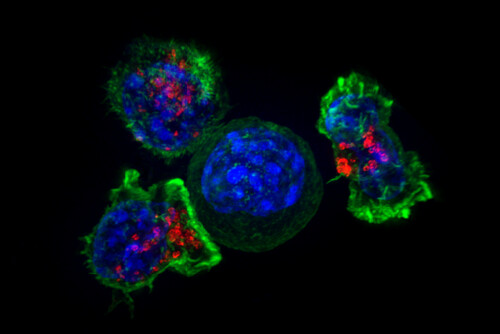Almost all living organisms experience infection, when the body is invaded by pathogens. To prevent and combat infections, ranging from the common cold to pneumonia, different parts of your immune system work together like a complex and well-oiled machine. Within your immune system, some white blood cells called killer T cells specialize in destroying cells that have become host to viruses in order to stop the reproduction of the viruses. Other types of white blood cells called memory B cells help with the prevention of infections by remembering and recognizing pathogens that the body has encountered before. This way, the body’s immune B cells can produce the right antibodies to combat pathogens faster.
Immune cells such as killer T cells and the memory B cells are essential to an organism’s survival. Without them, the body would easily be overwhelmed upon any contact with pathogens. But how do these cells know how to maintain such important tasks? How do T-cells who have never before encountered an antigen know how to effectively fight one? How are memory immune cells able to remember and recognize every of the tens of thousands of pathogens the body encounters on a daily basis?
Dendritic cells, a type of antigen-presenting cell, are a key main factor component in activating an immune response. During maturation, the process in which cells become differentiated for their specific bodily function, dendritic cells move from the tissue into lymph nodes, the parts of the body that fight infection and illness. Their maturation process includes antigen capturing in which they catch and travel with pathogens which will be presented to immune cells when mature. Dendritic cells capture antigens through a process called receptor-mediated endocytosis, or the cells’ energy-fueled method of transporting the antigens inside the cell. On the dendritic cell’s surface are receptors that bind to antigens and allow the cell to absorb the antigens.

Until the dendritic cells are mature, they do not present the antigens and are only antigen-capturing. Dendritic cells only become antigen-presenting cells once they have matured. Presenting antigens to other immune cells, specifically naive T-cells, causes immune activation. Naive T-cells are immune cells that are already mature (so they have a specific function) but have yet to encounter an antigen, which is required for their activation. Dendritic cells offer this service by presenting to them the first antigens the naive T cells have ever encountered, relative to major histocompatibility complex molecules (MHC). MHCs are involved in the immune system’s recognition of unfamiliar substances like antigens. Upon physical contact with dendritic cells along with costimulation– the process that triggers the activation of immune cells such as T-cells– from a number of other molecules, naive T cells can fully function as working immune cells. Activation begins with the signals that are sent to T cells and created at the immunological synapse, which is where the T cells and dendritic cells are in contact. As long as the synapse is intact, the dendritic cell can continue stimulation until the naive cell leaves. However, naive T cells’ activation process represents something of cutthroat competition for the stimulation. These immune cells often leave one dendritic cell for another if the other provides better stimulation, breaking the synapse with dendritic cells and ceasing stimulation. For example, imagine sitting in a restaurant only to leave immediately if the one next door offers food faster and at a higher volume, and imagine doing this until you feel satisfied. As such, naive T cells will flit from dendritic cell to a better dendritic cell until their activation is complete.
The immune system is a vastly complex system that relies on a number of functions and specialized cells to keep the body healthy. Without immune cells such as killer T-cells, the human body would easily fall prey to the vast number and variety of pathogens that invade the body on a daily basis. Killer T-cells’ function would decrease dramatically if it weren’t for dendritic cells teaching them how to fight the pathogens. Furthermore, there has been research attempting to use dendritic cells to increase T-cell activation as a way to fight illnesses such as cancer and COVID-19, and in other forms of immunotherapy. Dendritic cells have a huge role in keeping the body alive, and could also hold an equally important application in the future of medicine.
Sources:
- https://pubmed.ncbi.nlm.nih.gov/11406360/#:~:text=Dendritic%20cells%20are%20responsible%20for,the%20induction%20of%20peripheral%20tolerance.
- https://www.ncbi.nlm.nih.gov/books/NBK27156/
- https://www.ncbi.nlm.nih.gov/pmc/articles/PMC150864/
- https://www.cambridge.org/core/services/aop-cambridge-core/content/view/E5D1D7659B3F5C48161A4C97E4BB7E9A/S1466252304000143a.pdf/the-role-of-dendritic-cells-in-shaping-the-immune-response.pdf